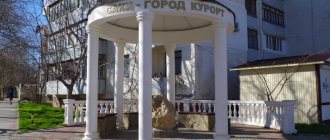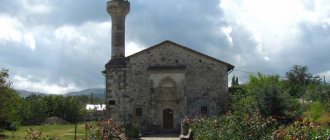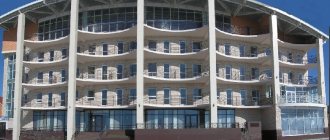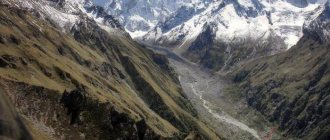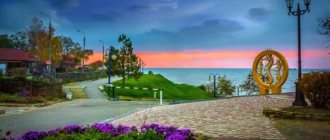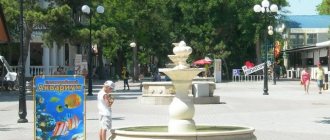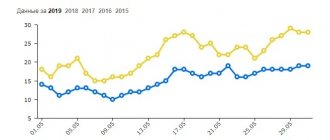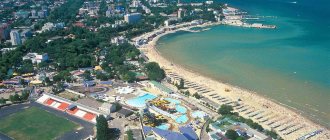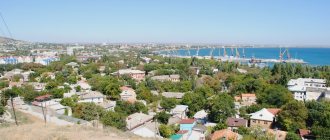Dzhankoy: areas, recreation, excursions, museums and churches, cuisine and restaurants, shopping and shops, attractions of Dzhankoy.
- Tours for the New Year
in Crimea - Last minute tours
to Crimea
Dzhankoy is a small cozy town in the northern part of Crimea, 93 km from Simferopol. It is very often called the “gate of the peninsula” - Dzhankoy, as it were, opens the Crimea. In addition, being an important railway junction, this city is the first to welcome tourists coming to Crimea.
“Dzhankoy” translated from Crimean Tatar means “soul-village” or “sweet village”, in the steppe dialect it means “new village”. During the Crimean Khanate, Dzhankoy was only a small village, and acquired the status of a city in 1917.
A little history
Dzhankoy has a rich Jewish history: in 1919, the Zionist organization Gekhalutz (He-Halutz) founded a center for training youth for agricultural work here, and in 1922, near the Kolay station (now Azovskoe), the first Jewish agricultural commune Tel was founded -Hai. Then a similar settlement appeared in Dzhankoy itself, and in 1933 it was turned into a collective farm. However, 1941 turned out to be fatal for the population of the commune: the collective farm was destroyed, and about 7 thousand Jews were shot in the winter of 1941-1942. during the Holocaust.
History of the Crimean city of Dzhankoy
The fate of the small village was changed by the construction of the railway, which gave a powerful impetus to its development. A few years later the settlement already had schools, a temple and a mosque. Residents built a gymnasium at their own expense. The national composition also changed: after the annexation of Crimea to Russia, the Tatars, who originally inhabited Dzhankoy, moved to Turkey. Their place was taken by German colonists who were actively involved in agriculture.
According to Wikipedia, the city of Dzhankoy was given city status on June 3, 1917. In 1925, there were 25 schools, a kindergarten, a clinic, and a library. Entire streets of new houses appeared.
The Great Patriotic War caused terrible damage to the city of Dzhankoy, Crimean region. Most of the enterprises, like the railway, lay in ruins, collective farms were destroyed. The casualties among the civilian population of Crimean Dzhankoy were horrific. But people overcame everything and revived and rebuilt the city.
Wines from Dzhankoy
The pride of the city is the wines produced here. It is generally accepted that local winemaking is more than 2000 years old, and the first winemakers of these places were the ancient Greeks. Whether it is a legend or not, nevertheless, the unique taste of Dzhankoy wine is loved by both residents and guests of Crimea. It is thick, sweet and strong.
Guests of the city will be able to get acquainted with amazingly tasty Crimean Tatar cuisine here. Near the station, according to local residents, there is the best cheburek shop in all of Crimea. In addition, there are many fruits and vegetables grown in a favorable climate, which means they are especially tasty.
Description of Dzhankoy
The Turkic name of the city, Dzhankoy, translates as “sweet village”. Indeed, previously in its place stood a wretched village with dugouts, the first mention of which dates back to the 18th century. After the appearance of a map of the Crimean peninsula at the beginning of the next century, the city of Dzhankoy was not there yet.
But everything is changing. Now Dzhankoy in the Republic of Crimea is a fairly significant city. For those who are interested in how old the city of Dzhankoy is, it is important to know the date of its first mention - 1855. Based on these data, on September 8 he will celebrate his 165th anniversary.
The area of the settlement is 26 km². This is the center of the Dzhankoy district; the city itself is not part of it, but is one of the subjects of direct republican subordination.
Today the population of the city of Dzhankoy is just over 38 thousand people. However, back in 1865, the population was only 117 people.
Holidays in Dzhankoy
The city is located far from the coast, therefore, unfortunately, it cannot boast of sandy beaches and gentle sea water. But Dzhankoy also has its own attractive sides.
- Nature and picturesque landscapes. Not far from the city, on an area of 12 thousand hectares, there is the regional landscape park-reserve “Kalinovsky”, one of the hotbeds of biodiversity in the region. On its territory there are more than 100 species of birds, settlements of waders, gulls, and cormorants.
- A minimum number of tourists and the absence of the bustle typical of big cities. Dzhankoy is a small, quiet and calm city. Young and active people will find it boring, but for those looking for peace and tranquility, it will be a completely suitable place for a short rest.
- The favorable climate and good location of the city is evidenced by the fact that this area has been inhabited since the time of the Crimean Khanate. It is first described in the “Cameral Description of Crimea 1784”.
Where is the city of Dzhankoy
The city is located in the north of Crimea. The place where the city of Dzhankoy is located has long been called the northern gate of the Crimean peninsula. The Dzhankoy railway junction played an important role in the life of the republic before the transport blockade by Ukraine, and after the launch of trains on the Crimean Bridge it continues to do so.
There is no sea in the vicinity of Dzhankoy, which is part of the Autonomous Republic of Crimea. But the Crimean steppe spreads around. And the Stepnaya River flows through the city itself. However, it’s not that far to get to the sea, even two of them: to Chernoe - 60 km, to Azov - 135 km. Travel companies in the city of Dzhankoy are ready to organize excursions to anywhere in the Crimean region. There is a lot of sun and warmth here - the southern summer is hot, dry and long. Summer temperatures in the territory where Dzhankoy is located in Crimea do not fall below +24⁰. High hills protect the city from gusts of steppe winds.
Weather in Dzhankoy
The climate of Dzhankoy is arid, moderately hot. The surrounding hills shelter the outskirts of the city from cold winds, and warm sea air, on the contrary, flows through a corridor into the valley. Summer is long and hot, the average temperature in July is +23 °C. Winters are mild, with frequent thaws and little snow. The average January temperature is -2 °C.
- Today
- Tomorrow
- December 16
, ThursdayCloudy, light rain
+6 °С during the day+6 °С at night
- December 17
, Friday
Cloudy, rain
+2 °С during the day+4 °С at night
- December 18
, Saturday
Cloudy, light rain
+3 °С during the day+2 °С at night
- Weather for 2 weeks
Where to stay
The city hosts several fairly large and comfortable hotels:
- “Chocolate” is the best hotel in the city, designed to accommodate 50 people at a time, who, in addition to standard single and double rooms, can choose temporary luxury and junior suite accommodation. Room cost from 2000 rubles. Regardless of the price, each room is equipped with a private bathroom, air conditioning, and wireless Internet. The local restaurant serves dishes of Russian, Ukrainian, and Tatar national cuisines. There is a bar. A guarded parking lot is provided. “Tavria” - the hotel is located in the very center, next to the railway station, each of the 80 rooms is equipped with a shower room, a split system, guests have a TV and Internet access.
- “Karpaty” - guests of the city pay tribute to the hotel for its traditional range of amenities. Additional advantages include free parking and a convenient location near the highway leading to Simferopol.
- “The Tsarskoye Podvorye” is the most elegant hotel in the city, but with a modest number of rooms it offers more comfortable conditions: in addition to the standard set of amenities, the apartments of the small hotel are equipped with an additional guest room with furniture.
- "Elbrus" is the newest hotel in the city with rooms equipped with a standard set of amenities. Nearby is the Lakomka cafe, which offers a good menu.
Marriages and divorces
Rosstat data show that the number of officially registered marriages in relation to the total number of citizens is decreasing every year. So, if in 1990 20,541 marriage records were registered, which amounted to 9.7 (per 1 thousand people), then in 2018-2020. Just over 11,000 marriages were registered annually. The coefficient dropped to 6-6.5.
2019 data
Men, like women, most often get married at the age of 25-34, but the percentage of women who decide to get married at 18-24 is also high, twice as high as the same figure for men in the same age group – 3500-4000 women for 1900-2000 men. A large number of marriages take place after 35 years. Early marriages are gradually becoming obsolete. If in 2000 - 2001. Before turning 18, 561 women formalized relationships; in 2021 there were only 50 such women, and in 2021 even less.
Of the 11,000 marriages concluded, approximately 6-7 thousand break up. This figure does not change from year to year. The lowest number of divorces was recorded in 2012-2013. During this period, the divorce rate was 1.2 and 1.1 compared to the current 3.5.
How to get there
Getting here is not difficult. Since this is the main railway junction of the peninsula and all trains on their route pass through this city. Highways connecting the northern part of Crimea with Kherson and Feodosia also pass through it.
From Moscow it is most convenient to fly to Simferopol, and then the remaining 93 kilometers by any means of transport: regular bus, train, minibus.
It may seem to you that Dzhankoy is far from luxury resorts, but, like a true Crimean, he cordially shares what he has. And there is not so little: inexpensive vacation, the opportunity to improve your health, enjoy the gifts of southern nature
0 0 votes
Article rating
Map of Dzhankoy with houses
The development of this small town was given by the railway, built at the end of the 19th century. An iron foundry was built next to it - the city's first industrial enterprise. The workers of this enterprise produced metal products for agriculture and industrial needs.
In the post-war years, the city began to deteriorate, new enterprises, houses, and cultural institutions were built. Looking at the map of Dzhankoy with houses, you can get an idea of the infrastructure of the settlement, which is quite favorable for the local residents to live. The city has:
- 8 kindergartens;
- 8 schools;
- hospitals;
- a park;
- aquapark;
- cinema;
- cultural center.
The city is practically buried in greenery of trees and bushes. And in the cozy courtyards there are children's playgrounds with swings and slides.
On the map of Dzhankoy with house numbers you can see the city’s housing stock, which is represented by both the private sector and comfortable houses. The center of Dzhankoy is considered the most prestigious place to live. Standard 5-storey and 9-storey buildings with comfortable apartments were built here. The center hosts all cultural events, and public transport runs frequently.
A large private sector is located between the railway line and Titov Street in the western part of Dzhankoy. This is a quiet neighborhood with its own school and several shops. There are no entertainment facilities in it, so local residents go to the center to relax.
Map of Dzhankoy with streets
Dzhankoy occupies an area with a total area of more than 26 square meters. km. It is divided into 2 parts by a railway, which was built at the end of the 19th century. and connected the settlement with other cities of Crimea. As the map of Dzhankoy with streets shows, the railway station is located in the area of Krymskaya Street - the oldest city transport artery. The longest street in Dzhankoy is Sovetskaya. It runs along the eastern outskirts of the city along the Military Town and the airfield.
The busiest streets are:
- Kutuzova;
- Titova;
- Maria Oktyabrskaya;
- Kalinina;
- Tolstoy;
- Lenin.
The city center is located in the area of Kalinin and Tolstoy streets. If you zoom in on the map of Dzhankoy with streets and houses, you can see that in this area there is a city market, a park and the Pokrovsky Cathedral.
There is a bus station not far from the train station. Dzhankoy is connected by bus to neighboring settlements, as well as to Sevastopol, Kherson and Kerch. You can get to the city along the M-17 highway, which runs along the northern outskirts of Dzhankoy. Using detailed maps of Dzhankoy, you can create driving routes and find out how to get to the desired object.
How to get to the city?
Many tourists living in the vastness of Russia are interested in the question of how to get to Dzhankoy. The distance from Moscow to it is 1310 km; it can be overcome in various ways. If you use a car as a means of transportation, the journey with short stops will take about a day. To do this, you need to take the E105 highway in the direction of Tula, through Belgorod, Kharkov and Dnieper.
The flight on the route “Moscow – Simferopol” lasts 2 hours 40 minutes. There are up to ten flights daily in this direction from Domodedovo Airport.
You can get from Simferopol to Dzhankoy in an hour and a half either by numerous trains or buses that travel daily from the capital of the republic to different cities of Crimea, or by taking a taxi. By car the route is like this:
Of course, Dzhankoy is not located on the seashore itself. However, for those who are looking for a calm and measured holiday in Crimea, it will definitely become a wonderful place to spend their holidays! Finally, we invite you to watch a short but very interesting video about this city. Enjoy watching!
Liked? Share with your friends!
Economy and industry of Dzhankoy
The city-forming enterprise of Dzhankoy is an elevator. Feed, flour, and vegetable oil are produced here. Grain is brought here from different regions of Crimea for processing and drying.
At the end of the last century, some factories ceased to exist, increasing the unemployment rate in the city. The following enterprises are currently operating stably:
- dairy;
- bakery;
- water fixture;
- meat processing plant
The city's enterprises produce household goods, reinforced concrete structures, and spare parts for cars.
Banks, government agencies, shopping centers, and public service enterprises operate in the city. There is also a large market for trading things and products, which is called “Collective Farm”.
